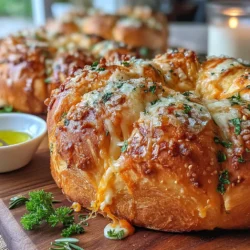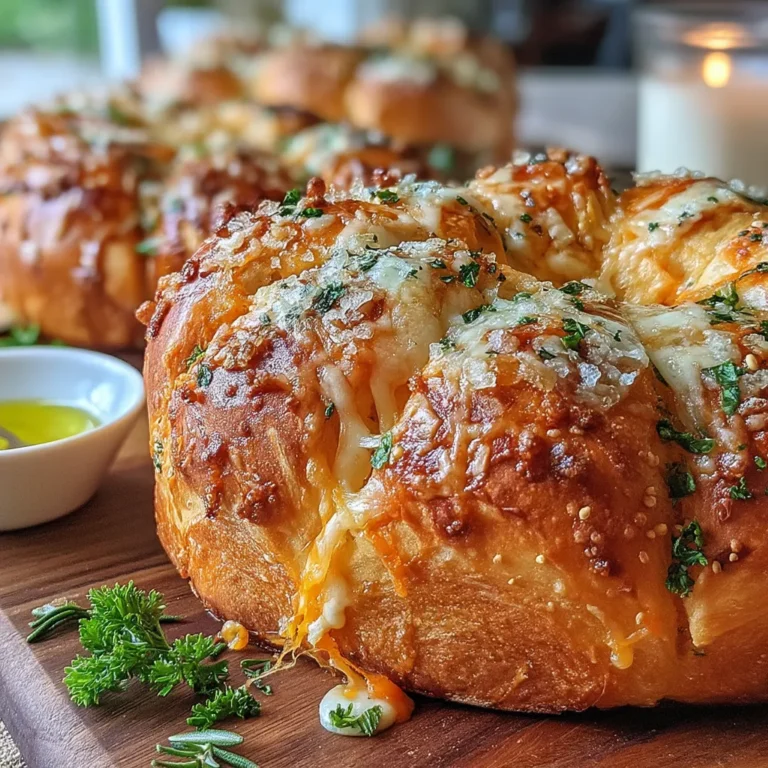Introduction
Savory Herb & Garlic Pull Bread is a delightful addition to any meal, known for its aromatic flavors and soft, pull-apart texture. This recipe combines the rich taste of garlic with a medley of fresh herbs, creating a bread that’s perfect for sharing at dinner parties or enjoying as a comforting snack. With its golden crust and cheesy surprise in every bite, this pull bread is sure to impress family and friends alike.
In this article, we will explore the step-by-step process of making this delicious bread, along with insights into its ingredients and tips for achieving the perfect loaf.
Recipe Overview
– Total Time: 2 hours
– Servings: 8
– Difficulty: Medium
Ingredients
– 4 cups all-purpose flour
– 1 packet (2 1/4 teaspoons) instant yeast
– 1 tablespoon sugar
– 1 teaspoon salt
– 1 1/2 cups warm water (110°F)
– 1/4 cup minced garlic
– 1 tablespoon fresh rosemary, chopped
– 1 tablespoon fresh thyme, chopped
– 1 tablespoon fresh parsley, chopped
– 1/2 teaspoon red pepper flakes (optional)
– 1 cup grated parmesan cheese
– 2 tablespoons olive oil
– Sea salt for garnish
– Additional fresh herbs for garnish

Instructions
1. In a small bowl, combine warm water, sugar, and instant yeast. Stir gently and let sit for about 5-10 minutes until foamy.
2. In a large mixing bowl, whisk together the flour and salt. Make a well in the center and pour in the yeast mixture.
3. Add the minced garlic, chopped herbs, and red pepper flakes (if using) to the flour mixture. Stir until the dough begins to come together.
4. Transfer the dough to a floured surface and knead for about 8-10 minutes until smooth and elastic.
5. Place the kneaded dough in a greased bowl, cover it with a clean kitchen towel, and let it rise in a warm spot for about 1 hour or until doubled in size.
6. Once risen, punch down the dough and divide it into small portions. Flatten each portion, sprinkle with parmesan cheese, and fold it over.
7. Arrange the pieces in a greased loaf pan, stacking them on top of each other. Drizzle with olive oil and sprinkle a little sea salt on top.
8. Cover the loaf pan with a towel and let it rise for another 30 minutes.
9. Preheat your oven to 375°F (190°C). Bake the bread for 25-30 minutes until golden brown and cooked through.
10. Allow the bread to cool slightly before serving. Garnish with more fresh herbs if desired.
Understanding the Ingredients
The Heart of the Recipe: Flour and Yeast
– The role of all-purpose flour in bread making
– How instant yeast works and why it’s preferred
– The importance of sugar and salt in dough development
Flavor Enhancers: Herbs and Garlic
– The impact of minced garlic on flavor profiles
– A closer look at the herbs: rosemary, thyme, and parsley
– Exploring the optional spice: red pepper flakes
The Finishing Touch: Cheese and Olive Oil
– The role of parmesan cheese in the recipe
– How olive oil contributes to texture and flavor
– The significance of sea salt and fresh herbs for garnish

Tips for Optimal Rising Conditions
Ensuring Optimal Rising Conditions
To achieve the best rise for your dough, it’s crucial to create a warm, draft-free environment. Ideal temperatures for yeast activation range from 75°F to 85°F (24°C to 29°C). You can use your oven as a proofing box by turning it on for a few minutes, then turning it off and placing your dough inside, covered with a damp cloth. Alternatively, placing the dough near a warm stove or in a sunlit spot can also foster ideal rising conditions.
Understanding the Science Behind Dough Rising
The rising process, known as fermentation, occurs when yeast consumes sugars and produces carbon dioxide, causing the dough to expand. The gluten structure strengthens during this time, contributing to the bread’s texture. Understanding this process helps you recognize the importance of patience; allowing your dough to rise adequately will result in a lighter, airier pull bread.
Shaping the Pull Bread
Techniques for Dividing and Shaping Dough Balls
Once your dough has risen, gently punch it down to release excess gases. Divide the dough into equal sections, about the size of a golf ball. Use your hands to shape each piece into a smooth ball, which will help achieve a uniform texture throughout the bread. This technique not only makes shaping easier but also contributes to an aesthetically pleasing final product.
Enclosing Cheese Within Dough
For a delicious surprise, consider enclosing cheese within some of the dough balls. Flatten each dough ball slightly, place a small cube or ball of cheese in the center, and fold the dough over to seal. This method ensures that the cheese remains hidden until you pull apart the bread, providing a delightful burst of flavor with each piece.
Assembling the Pull Bread
Tips for Arranging Dough in a Bundt or Cake Pan
When it comes to assembling your dough, a bundt or cake pan works beautifully. Start by lightly greasing the pan to prevent sticking. Arrange the dough balls in the pan, stacking them in layers if you wish. For an appealing presentation, alternate between plain and cheese-filled dough balls. This creates a visually stunning pull bread that is sure to impress.
Optional Toppings: Cheese and Sea Salt
Before the final rise, consider sprinkling some grated cheese and coarse sea salt over the top for added flavor and texture. This simple addition enhances the savory profile of your bread and gives it a golden, crusty top once baked.
Second Rise: Final Touches
The Importance of the Second Rise for Texture
The second rise is crucial for developing the final texture of your pull bread. This period allows the dough to relax and continue fermenting, which improves its flavor and lightness. Aim for a rise of about 30 minutes to an hour, until the dough has visibly puffed up.
Maintaining Warmth for Optimal Rising
To maintain warmth during the second rise, cover the pan with a clean kitchen towel or plastic wrap. If your kitchen is particularly cool, you can place the covered pan in a warm spot or use the oven trick again, ensuring that the dough has a cozy environment to expand.
Baking the Bread
Preheating the Oven: Why Temperature Matters
Preheating your oven to the right temperature (usually around 350°F to 375°F or 175°C to 190°C) is essential for achieving the desired crust and texture. A properly preheated oven ensures even baking and allows the bread to rise rapidly when it first enters, resulting in a fluffy interior.
Visual and Auditory Cues for Knowing When the Bread Is Done
Your bread is ready when it turns a golden-brown color, and you can tap the bottom of the pan, hearing a hollow sound. Additionally, a temperature of 190°F (88°C) in the center of the bread indicates that it is fully baked.
Cooling and Serving
Best Practices for Cooling Bread
Once baked, remove the pull bread from the oven and allow it to cool in the pan for about 10 minutes. Then, gently transfer it to a wire rack to cool completely. This step prevents steam from building up and keeps the crust crispy.
Creative Serving Suggestions, Including Dips and Pairings
Pull bread is best served warm and can be accompanied by a variety of dips such as marinara, garlic butter, or herb-infused olive oil. For a heartier meal, pair it with soups or stews, making it a versatile addition to any dining table.
The Joy of Sharing Pull Bread
The Social Aspect of Bread
Sharing pull bread at gatherings creates a communal atmosphere, encouraging guests to interact as they pull apart pieces. It’s a dish that invites conversation and connection, making it perfect for family dinners or festive occasions.
Creative Ways to Serve and Enjoy
Consider serving your pull bread with a variety of toppings or spreads. Fresh herbs, flavored butters, or even a cheese board can elevate the experience, allowing guests to customize their servings.
Pairing Suggestions
Complementary Dishes to Serve Alongside Pull Bread
Serve your savory herb and garlic pull bread alongside salads, roasted vegetables, or charcuterie boards for a balanced meal. The bread’s flavors complement a range of dishes, making it a versatile side.
Beverage Pairings
Wine enthusiasts will enjoy pairing this pull bread with a crisp white wine or a light red. Non-alcoholic options such as sparkling water with lemon or herbal teas also provide a refreshing contrast to the savory notes of the bread.
Conclusion: The Delight of Homemade Savory Herb & Garlic Pull Bread
Homemade Savory Herb & Garlic Pull Bread is not just a recipe; it’s an experience that brings people together. The delightful aroma that fills your kitchen as it bakes, the joy of pulling apart the soft, cheesy pieces, and the satisfaction of sharing this warm, flavorful bread make it a truly rewarding endeavor. Whether enjoyed on a festive occasion or a cozy weeknight dinner, this bread is bound to become a favorite in your household. Embrace the art of bread-making and savor the delicious results that come from your kitchen.

Savory Herb & Garlic Pull Bread
Ingredients
- 3.5 cups all-purpose flour
- 2.25 tsp instant yeast
- 1 tsp sugar
- 1 tsp salt
- 1 cup warm water
- 0.25 cup olive oil
- 5 cloves garlic, minced
- 1 tbsp fresh rosemary, chopped
- 1 tbsp fresh thyme, chopped
- 1 tbsp fresh parsley, chopped
- 0.5 cup grated parmesan cheese
- 0.25 tsp red pepper flakes
- tsp sea salt, for sprinkling
- none fresh herbs for garnish
Instructions
- Activate the Yeast: In a small bowl, mix warm water, sugar, and instant yeast. Let it sit for about 5-10 minutes until it becomes frothy.
- Prepare the Dough: In a large mixing bowl, combine flour, salt, minced garlic, rosemary, thyme, parsley, and red pepper flakes (if using). Create a well in the center and pour in the yeast mixture and olive oil.
- Mix the Dough: Stir the mixture to form a rough dough. Use your hands to knead the dough in the bowl for about 3-5 minutes until it is smooth and elastic. If the dough is sticky, add a touch more flour.
- First Rise: Lightly grease a bowl with olive oil and place the dough inside. Cover it with a clean kitchen towel or plastic wrap. Allow it to rise in a warm place for about 1 hour or until it has doubled in size.
- Shape the Bread: Once risen, punch down the dough and transfer it to a floured surface. Divide the dough into small pieces (about the size of a golf ball). Flatten each piece and place a pinch of parmesan cheese in the center, then fold the dough around the cheese and roll into a ball.
- Assemble the Pull Bread: Grease a bundt pan or a round cake pan with olive oil. Arrange the dough balls in the pan, placing them closely together (they will rise and fill in the gaps). Optionally, sprinkle additional parmesan cheese and sea salt on top.
- Second Rise: Cover the pan and let the dough balls rise again for about 30-45 minutes until they are puffed up.
- Preheat the Oven: Meanwhile, preheat your oven to 375°F (190°C).
- Bake the Bread: Once the second rise is complete, place the pan in the oven and bake for 25-30 minutes or until the top is golden brown and the bread sounds hollow when tapped.
- Cool and Serve: Remove from the oven and allow the bread to cool for about 10 minutes in the pan. Then, gently turn out the bread onto a serving platter. Garnish with fresh herbs, if desired, and serve warm with olive oil for dipping.
